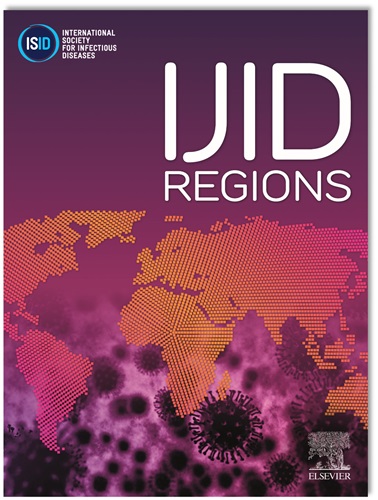Adverse events of tuberculosis preventive therapy among individuals with latent tuberculosis infection: A nationwide cohort study in South Korea
IF 4.8
2区 医学
Q1 INFECTIOUS DISEASES
引用次数: 0
Abstract
Objectives
This study assessed adverse event with tuberculosis preventive therapy (TPT) regimens among individuals with latent tuberculosis infection (LTBI).
Methods
Using national health insurance data, we analyzed individuals newly diagnosed with LTBI between 2015 and 2020. The TPT group, prescribed 3 months of isoniazid and rifampicin (3HR), 4 months of rifampicin (4R), or 9 months of isoniazid (9H), was matched with a control group through 1:1 propensity score matching. Drug-related adverse events were reported.
Results
Of 220,483 diagnosed with LTBI, 49.0% received TPT, primarily 3HR (74.6%). The incidence of any adverse events with TPT was 11.90%, with 8.94% of these events being severe events requiring hospitalization. Hepatotoxicity risk was 6.48-, 4.79-, and 3.50-fold with 3HR, 9H, and 4R, respectively, compared to controls. Severe cutaneous adverse reaction risk was 4.27-, 1.83-, and 1.93-fold with 3HR, 9H, and 4R. 4R had the lowest risk of any adverse events, while 3HR had the highest. Permanent discontinuation occurred in 2.3%, 3.1%, and 3.3% with 4R, 9H, and 3HR, respectively. Unlike 9H, rifampicin-based regimens showed no age-related trend in adverse event risk.
Conclusions
4R is a better option considering safety across a broad age range, suggesting it could be encouraged in the LTBI population.
结核预防治疗在潜伏性结核感染个体中的不良事件:韩国一项全国性队列研究。
目的:本研究评估结核预防治疗(TPT)方案在潜伏性结核感染(LTBI)个体中的不良事件。方法:利用国家健康保险数据,我们分析了2015年至2020年间新诊断为LTBI的个体。TPT组分别给予异烟肼加利福平3个月(3HR)、利福平4个月(4R)或异烟肼9个月(9H),通过1:1倾向评分匹配与对照组进行匹配。报告了与药物相关的不良事件。结果:220,483名LTBI患者中,49.0%接受了TPT治疗,主要是3HR(74.6%)。TPT的不良事件发生率为11.90%,其中8.94%为需要住院治疗的严重事件。与对照组相比,3HR、9H和4R组的肝毒性风险分别为6.48、4.79和3.50倍。严重皮肤不良反应风险分别是3HR、9H和4R组的4.27倍、1.83倍和1.93倍。4R组不良事件发生率最低,3HR组最高。在4R、9H和3HR时,永久停药的发生率分别为2.3%、3.1%和3.3%。与9H不同,以利福平为基础的方案在不良事件风险方面没有与年龄相关的趋势。结论:考虑到广泛年龄范围内的安全性,4R是一个更好的选择,建议在LTBI人群中鼓励使用。
本文章由计算机程序翻译,如有差异,请以英文原文为准。
求助全文
约1分钟内获得全文
求助全文
来源期刊
CiteScore
18.90
自引率
2.40%
发文量
1020
审稿时长
30 days
期刊介绍:
International Journal of Infectious Diseases (IJID)
Publisher: International Society for Infectious Diseases
Publication Frequency: Monthly
Type: Peer-reviewed, Open Access
Scope:
Publishes original clinical and laboratory-based research.
Reports clinical trials, reviews, and some case reports.
Focuses on epidemiology, clinical diagnosis, treatment, and control of infectious diseases.
Emphasizes diseases common in under-resourced countries.

 求助内容:
求助内容: 应助结果提醒方式:
应助结果提醒方式:


